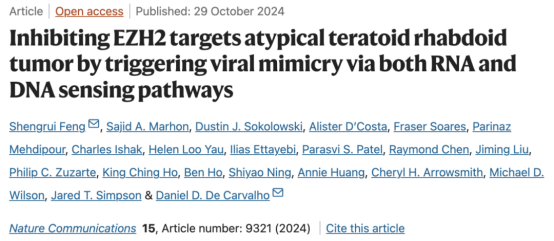Atypical teratoid rhabdoid tumor (ATRT) is a rare but highly aggressive pediatric tumoraffectingthe brainspinal cord. The hallmark of this disease is the loss of the SMARCB1 gene, a key driver mutation that causessignificantupregulationofEZH2, a proteincritical for tumor growth. Although EZH2 inhibitors havedemonstratedpromising results in both preclinicalclinical studies, their exact mechanism of actionremains incompletely understood.
Recently, the team led by Shengrui Fengfrom the First Affiliated Hospital of University of South China, in collaboration with the Princess Margaret Cancer Centre in Toronto, Canada, published a major research article in the prestigious international journalNature Communications (Chinese Academy of Sciences Quartile I,top journal, Impact Factor: 14.7). The study, titled “Inhibiting EZH2 targets atypical teratoid rhabdoid tumor by triggering viral mimicry via both RNADNA sensing pathways”, demonstrates that EZH2 inhibitors induce virus-like characteristics in cancer cells viabothRNADNA sensing pathways, thereby effectively suppressing tumor progression.

Keyfindings of the study include:
1.SMARCB1 lossviral mimicry
The study found that loss of SMARCB1 induces a viral infection-like state in tumor cells, characterized by elevated levels of double-stranded RNA (dsRNA). Treatment with EZH2 inhibitors significantly amplifies this viral mimicry effect, making SMARCB1-deficient tumor cells more sensitive to EZH2-targeted therapy.
2.Dual pathway activation
EZH2 inhibitors exert their effects by simultaneously activatingboththe RNA sensing pathway (MDA5/MAVS)the DNA sensing pathway (cGAS/STING). The study demonstrated thatinhibition ofboth pathwaysis necessaryto completely suppress the immune responses induced by EZH2 inhibitors.
3.RNA sensing andIR-Alus
The study furtherrevealed thatIR-Alus,theintronic repeat elements located within interferon-stimulated genes, form double-stranded RNAthat establishes a positive feedback loop that reinforces viral mimicry. Thisfinding offersimportant insightthe RNA sensing mechanism.
4.DNA sensingLINE1
EZH2 inhibitorsremoveH3K27me3 modifications, reactivating young LINE1 elements and leading to reverse transcriptionDNA damage. This sequence of events activates the cGAS/STING pathway, an effectthatcan be mitigatedeitherbyusingreverse transcriptase inhibitorsby depleting LINE1 elements.
Associate Professor Shengrui Feng,thefirstcorresponding author of the study, stated: “By elucidating the viral mimicry response triggered by EZH2 inhibition, our research uncovers a critical mechanism involving the cooperation of RNADNA sensing pathways. This opens new avenues for optimizing epigeneticimmunotherapeutic strategiesforATRT patients.” — The study not only provides a novel therapeutic direction for ATRT but alsolays the groundwork for treating other tumors associated with SMARCB1 loss.

